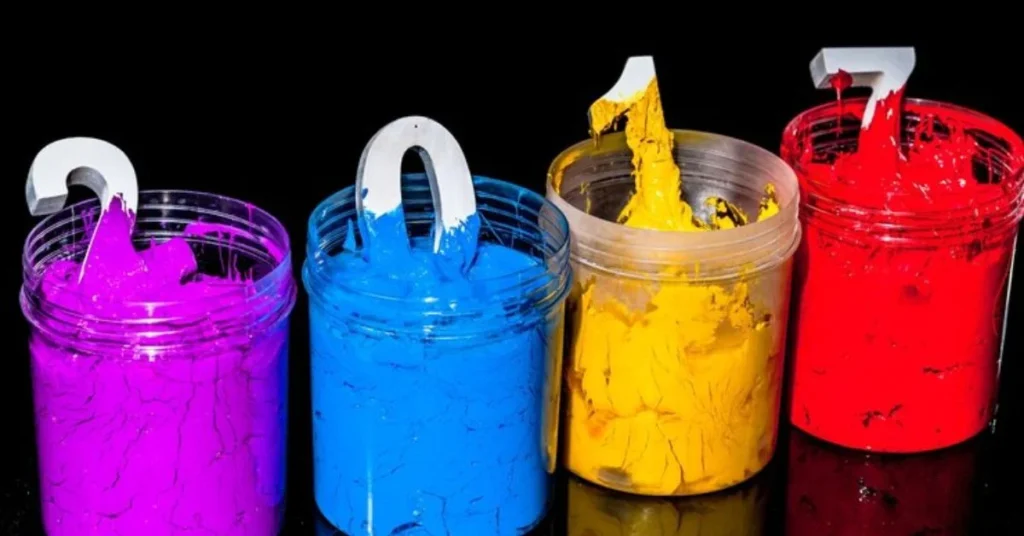For printers looking to reproduce high-detail, photo-realistic images on fabric, few solutions are as a black cotton tee or simulating a magazine-quality image for a fashion brand, plastisol CMYK screen printing remains a staple in textile graphics.
But beneath the surface lies a complex world of color theory, dot angles, mesh counts, viscosity, and curing temperatures. This article explores what plastisol CMYK ink really is, how it’s used in textile and promotional printing, and what you need to know before trying—or trusting—this method.
What Is Plastisol CMYK Ink?
Plastisol ink is a PVC-based ink system commonly used in screen printing on textiles. It does not dry by evaporation; instead, it cures when heated to a certain temperature (typically around 320°F or 160°C), causing the plasticizers to bond with the fabric.
CMYK stands for Cyan, Magenta, Yellow, and Black (Key) — the four-color process used to reproduce full-color images in print. Instead of mixing ink colors to match a design, CMYK printing layers these four semi-transparent inks in precise dot patterns to simulate a wide range of colors.
So, Plastisol CMYK ink refers to a four-color plastisol ink system that allows you to reproduce full-color, photo-quality images on fabric using screen printing.
How Does Plastisol CMYK Printing Work?
At its core, plastisol CMYK printing is process color printing applied to textiles. Here’s how it works step-by-step:
1. Color Separation
The original image is separated into its four CMYK components using specialized software. Each channel represents one ink and is converted into a halftone pattern—tiny dots of varying sizes that create the illusion of gradient tones.
2. Screen Preparation
Each of the four colors is assigned to a different mesh screen. Mesh count is crucial:
- Higher mesh (230–355) for fine halftone dots
- Tight tension ensures dot accuracy
3. Ink Selection
Plastisol CMYK inks are semi-transparent and lower in opacity than standard spot colors. This allows for blending between overlapping halftone dots, which is essential for photo-like color fidelity.
4. Printing Order
The inks are usually printed in the following order:
- Yellow
- Magenta
- Cyan
- Black (Key)
This order helps optimize color mixing on the fabric and preserve clarity.
5. Curing
After printing, the ink must be heat-cured using a conveyor dryer. Incorrect curing (too hot, too fast, or uneven) can result in dull images or ink washout.
Why Use Plastisol CMYK Ink Instead of Other Methods?
There are several ways to print full-color images on garments—DTG (Direct to Garment), sublimation, or transfer paper, to name a few. But plastisol CMYK has distinct advantages:
| Advantage | Description |
| Durability | Plastisol ink is known for its longevity after washes. |
| Color Fidelity | When executed correctly, it delivers near-photo realism. |
| Cost-Effective for Volume | Ideal for medium to large runs compared to DTG. |
| Ink Versatility | Works on cotton, cotton blends, and even synthetics. |
| Controlled Finish | Can be matte or gloss depending on base and technique. |
That said, it’s not a beginner’s technique. CMYK plastisol printing requires experience in halftone control, screen tension, and curing discipline to get right.

Key Factors That Determine Print Quality
The quality of a plastisol CMYK print is dependent on many small variables. Let’s break down the most critical ones:
1. Mesh Count and Screen Tension
- Use 305 mesh (or higher) for CMYK printing
- Ensure screens are tensioned above 25 N/cm
This ensures halftone dots remain sharp and don’t bleed.
2. Halftone Angle and Frequency
- Use standard CMYK angles (e.g., C: 15°, M: 75°, Y: 90°, K: 45°)
- Line count: 55–65 LPI (lines per inch)
Too high an LPI on coarse garments leads to dot loss; too low results in a grainy image.
3. Off-Contact and Squeegee Pressure
- Light, consistent pressure preserves dot shape
- Proper off-contact distance (1/16”–1/8”) reduces smearing
4. Underbase or No Underbase?
- On white garments: Print CMYK directly
- On dark garments: Consider using a discharge underbase or a high-opacity white base followed by CMYK layers
The underbase approach is controversial—some say it alters transparency behavior of the inks, so test prints are essential.
5. Curing Consistency
- Conveyor dryers must be calibrated
- Spot-check with heat probes or plastisol temperature strips
Improper curing leads to cracking, dullness, or fading after just a few washes.
Innovations in Plastisol CMYK Ink (2024–2025)
While plastisol technology is decades old, it has seen notable innovation recently:
– Low-Cure Plastisol
Inks now cure at 270°F–280°F, reducing fabric scorch risk and saving energy.
– Phthalate-Free and Eco Plastisols
These inks meet global compliance standards (e.g., OEKO-TEX, REACH) without sacrificing performance.
– Hybrid CMYK Systems
Some manufacturers now offer CMYK plastisol with a digital underbase, combining screen and digital printing for ultra-detailed jobs.
– Expanded Gamut Printing
Adding orange and green inks to CMYK allows for 6-color process printing, improving vibrancy and color match on complex images.
Applications: When and Where to Use Plastisol CMYK
This method is not for every print job—but it shines in certain scenarios:
| Use Case | Why It’s Ideal |
| Band Merchandise | Photo-realistic album covers or promo images on tees |
| Promotional Wear | Colorful company logos for events and giveaways |
| Fashion Graphics | Artistic prints requiring soft hand and high detail |
| Sportswear | Jersey sponsors, team crests, or commemorative shirts |
| Event Printing | Marathon tees, campaign shirts, or one-time releases |
If you’re printing a vector logo with solid colors, go with spot color plastisol. But for photographic or gradient-based designs, CMYK plastisol excels.
Common Challenges and How to Avoid Them
Even experienced screen printers can struggle with CMYK plastisol. Here are common pitfalls:
– Color Muddying
Occurs when dot angles are incorrect or inks are overlaid too heavily. Always verify screen alignment and reduce squeegee pressure.
– Dot Gain
Halftone dots become larger during printing, leading to darker or over-saturated results. Control ink flow and check for emulsion thickness consistency.
– Washed-Out Images
Usually a sign of under-curing. Use a temperature gun on test garments to confirm ink film reaches 320°F.
– Banding or Striping
Can result from inconsistent screen coating or off-angle squeegee pulls. Maintain uniform pressure and use sharp, high-durometer blades.
Is It Right for Beginners?
Plastisol CMYK printing is advanced screen printing, requiring:
- RIP software knowledge
- Screen-making precision
- Curing accuracy
- Printroom control
However, beginners can experiment with CMYK using pre-separated artwork and starter kits to learn the process on a small scale. It’s a technical challenge—but rewarding when mastered.
Tools and Equipment Checklist
To produce high-quality plastisol CMYK prints, you’ll need:
- High-tension aluminum screens (305 mesh or higher)
- Quality plastisol CMYK ink set
- Accurate RIP software (e.g., AccuRIP, Separation Studio)
- Exposure unit with vacuum seal for fine halftone retention
- Registration system (micro-registration a must)
- Conveyor dryer with stable temperature control
- Color densitometer or light table for QC
This setup ensures color fidelity and repeatability—essential for commercial-grade printing.
Conclusion
Plastisol CMYK ink remains a pinnacle of analog color reproduction in textile printing, combining chemistry, mechanical precision, and artistic vision. While other methods like DTG and DTF have gained traction, screen printing with CMYK plastisol still provides exceptional quality, longevity, and scalability when executed with skill.
It is not an easy method to master. But for those who invest the time in learning halftone mechanics, mesh discipline, and curing science, the reward is a process that can print anything from a high-res concert photo to a full-color portrait on a black tee—with stunning realism and unmatched durability.
As the printing industry continues to evolve, hybrid and eco-formulations of plastisol CMYK are opening new doors, making this technique not only relevant but rejuvenated for the modern apparel market.
FAQs
1. What makes plastisol CMYK ink different from standard plastisol ink?
Plastisol CMYK ink is more transparent and designed for halftone blending. It’s used for photo-quality images, while standard plastisol is opaque and used for solid colors.
2. Can I use plastisol CMYK inks on dark shirts?
Yes, but you’ll need a discharge or white underbase to preserve color accuracy. Without it, colors may appear muted or inaccurate.
3. What mesh count should I use for CMYK screen printing?
Ideally, 305 mesh count or higher. This ensures fine halftone dots are preserved and don’t flood with ink.
4. Is plastisol CMYK printing eco-friendly?
Modern plastisol CMYK inks are often phthalate-free and comply with international safety standards. However, they are still PVC-based. Water-based CMYK inks are more eco-friendly but harder to control.
5. Can beginners try plastisol CMYK printing at home?
It’s possible with starter kits and simplified designs, but professional-level results require skill, precision equipment, and experience with screen setup and color separation.
For more information, click here.









